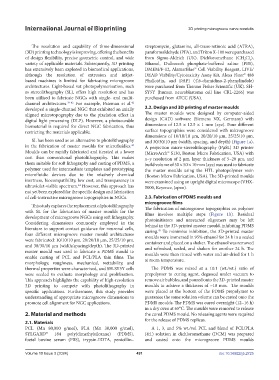Page 499 - IJB-10-3
P. 499
International Journal of Bioprinting 3D printing microgroove nerve conduits
The resolution and capability of three-dimensional streptomycin, glutamine, all-trans-retinoic acid (ATRA),
(3D) printing technology is improving, offering the benefits paraformaldehyde (PFA), and Triton X-100 were purchased
of design flexibility, precise geometric control, and wide from Sigma-Aldrich (UK). Dichloromethane (CH Cl ),
2
2
variety of applicable materials. Subsequently, 3D printing Ethanol, Dulbecco’s phosphate-buffered saline (PBS),
has extensively been explored in biomedical applications, DMEM/F-12, AlamarBlue™ Cell Viability Reagent, LIVE/
although the resolution of extrusion and inkjet- DEAD Viability/Cytotoxicity Assay Kit, Alexa Fluor® 488
based machines is limited for fabricating microgroove Phalloidin, and DAPI (4’,6-diamidino-2-phenylindole)
architectures. Light-based vat photopolymerisation, such were purchased from Thermo Fisher Scientific (UK). SH-
as stereolithography (SL), offers high resolution and has SY5Y (human neuroblastoma cell line CRL-2266) was
been utilised to fabricate NGCs with single- and multi- purchased from ATCC (USA).
channel architectures. 39-42 For example, Pateman et al.
42
developed a single-channel NGC that exhibited an axially 2.2. Design and 3D printing of master moulds
aligned microtopography due to the pixelation effect in The master moulds were designed by computer-aided
digital light processing (DLP). However, a photocurable design (CAD) software (Siemens NX, Germany) with
biomaterial is required for direct NGC fabrication, thus dimensions of 12.5 × 12.5 × 1 mm (xyz). Four different
restricting the materials applicable. surface topographies were considered with microgroove
dimensions of 10/10/10 µm, 20/20/10 µm, 25/25/10 µm,
SL has been used as an alternative to photolithography and 30/30/10 µm (width, spacing, and depth) (Figure 1a).
in the fabrication of master moulds for microfluidics. A projection micro-stereolithography (PµSL) 3D printer
43
Moulds can be rapidly fabricated and iterated at a lower (MicroArch™ S130, Boston Micro Fabrication, USA) with
cost than conventional photolithography. This makes x–y resolution of 2 µm, layer thickness of 5–20 µm, and
them suitable for soft lithography and casting of PDMS, a build volume of 50 × 50 × 10 mm (xyz) was used to fabricate
polymer used for intermediate templates and prototyping the master moulds using the HTL photopolymer resin
microfluidic devices due to the relatively chemical (Boston Micro Fabrication, USA). The 3D-printed moulds
inertness, biocompatibility, low cost, and transparency in were examined using an upright digital microscope (VHX-
ultraviolet-visible spectrum. However, this approach has 5000, Keyence, Japan).
44
not yet been explored for the specific design and fabrication
of cell-instructive microgroove topographies in NGCs. 2.3. Fabrication of PDMS moulds and
microgroove films
This study explores the replacement of photolithography The fabrication of microgroove topographies on polymer
with SL for the fabrication of master moulds for the films involves multiple steps (Figure 1b). Residual
development of microgroove NGCs using soft lithography. photoinitiators and unreacted oligomers may be left
Considering dimensions commonly employed in the behind in the 3D-printed master mould, inhibiting PDMS
literature to support contact guidance for neuronal cells, curing. To minimise inhibition, the 3D-printed master
45
four different microgroove master mould architectures moulds were immersed in 95% ethanol for 24 h in a sealed
were fabricated: 10/10/10 µm, 20/20/10 µm, 25/25/10 µm, container and placed on a shaker. The ethanol was removed
and 30/30/10 µm (width/spacing/depth). The 3D-printed and refreshed, sealed, and shaken for another 24 h. The
master mould was used to fabricate a PDMS mould to moulds were then rinsed with water and air-dried for 1 h
enable casting of PCL and PCL/PLA thin films. The at room temperature.
morphology, roughness, mechanical, wettability, and
thermal properties were characterised, and SH-SY5Y cells The PDMS was mixed at a 10:1 (wt./wt.) ratio of
were seeded to evaluate morphology and proliferation. prepolymer to curing agent, degassed under vacuum to
This approach highlights the capability of high-resolution remove air bubbles, and poured onto the 3D-printed master
3D printing to compete with photolithography in moulds to achieve a thickness of ~10 mm. The moulds
specific applications. Furthermore, this study provides were placed at the bottom of the PDMS prepolymer to
understanding of appropriate microgroove dimensions to guarantee the same solution volume can be casted onto the
promote cell alignment for NGC applications. PDMS moulds. The PDMS was cured overnight (12–16 h)
in a dry oven at 65°C. The moulds were removed to release
2. Material and methods the cured PDMS mould. No releasing agents were required
for the release of PDMS replicas.
2.1. Materials
PCL (Mn 80,000 g/mol), PLA (Mn 30,000 g/mol), A 1, 3, and 5% wt./vol PCL and blend of PCL/PLA
SYLGARD™ 184 poly(dimethylsiloxane) (PDMS), (4:1) solution in dichloromethane (DCM) was prepared
foetal bovine serum (FBS), trypsin-EDTA, penicillin– and casted onto the microgroove PDMS moulds
Volume 10 Issue 3 (2024) 491 doi: 10.36922/ijb.2725

